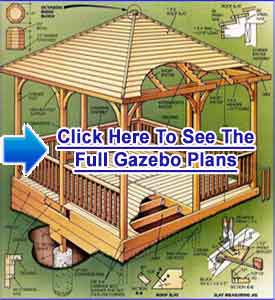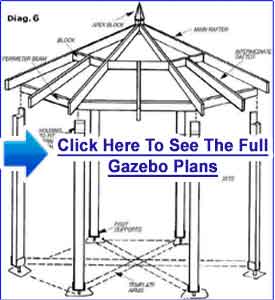 Having gazebo construction plans to help you out in your DIY project is a great trick, but do you know that there are some more tips and tricks you can do for your gazebo? Not only are gazebos elegant and charming outdoor decoration pieces, they are also functional open-air rooms for families and friends. There are many things you can tweak in the design and construction of a gazebo—tweaks that adds that subtle personal touch that marks your structure as something all your own.
Having gazebo construction plans to help you out in your DIY project is a great trick, but do you know that there are some more tips and tricks you can do for your gazebo? Not only are gazebos elegant and charming outdoor decoration pieces, they are also functional open-air rooms for families and friends. There are many things you can tweak in the design and construction of a gazebo—tweaks that adds that subtle personal touch that marks your structure as something all your own.
Making Your Own Gazebo Construction Plans Versus Getting Them Online
Making a gazebo all by yourself—right from making your own plans down to finishing the construction—is a challenging and rewarding thing. Nothing can match the feeling of creating something with your bare hands. Not to mention the fact that being your own architect also means you have every bit of control over your gazebo.
That being said, making your own gazebo constructions plans —especially if you are inexperienced—has the potential for a lot of disastrous mistakes. There are details in construction that should be done meticulously—things like balance, weight of materials, etc—that require years of knowledge to perfect.
Fortunately, there are designs and plans that are available online. Some are free, while some are sold. If you are unsure of how to start, or you just do not have the time to fiddle with your ruler and sketchpad, getting gazebo plans online might be the best choice for you.
Types Of Materials Used In Outdoor Gazebo Plans
Depending on the look you are going for, you can use a variety of materials for your gazebo, like wood, metal, cement, brick, or a combination of these. Choosing which material to use will depend on the location of your gazebo, and the overall look you are going for.
Wooden gazebos are the most common type of gazebos. These are perfect for areas that can only support lightweight materials, and for designs that require intricate chiseled designs. If you have an Asian-inspired garden, you can choose to build a pagoda-type gazebo to accentuate the overall theme.
Metal, cement, and brick gazebos are heavier, but sturdier types. These will more likely be able to withstand outdoor elements like rain and snow far better than a wooden gazebo would, but will be quite limited in terms of design. Most outdoor gazebo plans require just one type of material, though it is possible to mix and match.
Wooden Gazebo Plans Tips And Tricks
If you are going for a more rustic or romantic feel, look for wooden gazebo plans and designs. Wooden gazebos offer the most flexibility in terms of design, not to mention that wooden gazebos are also the least expensive. They are suitable for gardens, decks, and rooftop areas because of their weight.
The one setback of wooden gazebos is that they are not as durable as other materials. Wood tends to rot when repeatedly soaked in water, not to mention that they are flammable and damageable by termites. There are tips and tricks you can do to compensate those problems, though.
If the area you will putting your gazebo in is in a relatively dry and sunny place, you can use materials like gypsum boards, which are lightweight, non-flammable, and sturdy as regular boards. For areas that will have their share of rain and snow, there are treatments for wood that will make it resistant to water and termites, as well as paint and varnish that can further protect it from moisture.
Gazebo Deck Plans Tips and Tricks
If you are planning to build your gazebo on a platform, like a deck, your best bet would be a wooden or a metal gazebo. The more common wooden decks may or may not be able to support a lot of weight, so building a brick or stone and cement gazebo might be too heavy.
You can opt to have a metal gazebo. Metal gazebos are not as heavy as brick or cement, and are longer-lasting than wooden ones. Wrought iron can bring a gothic or old-world feel to your deck, and you can twist iron into intricate designs as well.
Gazebo Building Plans Using Cement, Brick, Or Stone
The sturdiest of all gazebo materials are those made from cement, brick, or stone. These gazebos can endure the harshest weather and climate change, so you are sure that they will stand the test of time.
The only drawback to a cement, brick, or stone gazebo is that designs are limited for a beginner. Intricate designs are hard to create in cement—though you can use cement molds for that. Still, stone or brick gazebos bring their own level of charm to any garden.
One thing to remember is that as these are the types of gazebos that have the most weight, it is a good idea to use them only when you plan to build a gazebo on level ground. Gardens and backyards are the perfect places for gazebo building plans asking for these materials.
Understanding Gazebo Blueprints
If you have not seen a blueprint before, it would probably be best to ask help from someone who can understand it. Gazebo blueprints—like any other blueprint—have all sorts of annotations that only architects, engineers, and people in the construction business can understand.
On the other hand, if you are the one making the blueprints, make sure to print them as precisely as you can, especially if you are going to ask for help later on. If there will be other people helping you saw wood or cut metal, it would be best if everyone understands the instructions clearly.
When Going For Gazebo Plans For Sale
If anything, you can always go for gazebo construction plans that are for sale. There is nothing wrong with using a ready-made plan for your DIY project. It will even save you time and effort from the designing and planning.
When you are looking for gazebo plans for sale, make sure that you are completely happy with the overall look and build. Do not go for something that looks okay or is plain good enough, because you might regret it after the project is finished. If you cannot find something that you are 100% happy with, go for something that looks the closest to what you have in mind. Tweaking the design will be easier that way.
Also, try not to skim the places and sites when you look for gazebo construction plans. You never know where you will find hidden gems. There are independent architects, landscape hobbyists, and the like, who can help you build your dream gazebo, so lurk around forums and online communities. It is better to have your search pay off than to put a little effort and end with a so-so gazebo.







